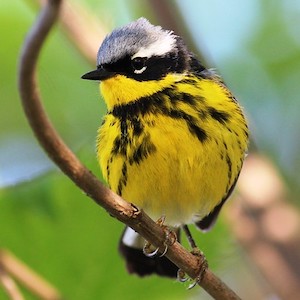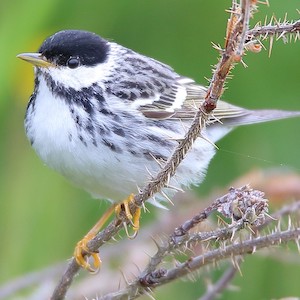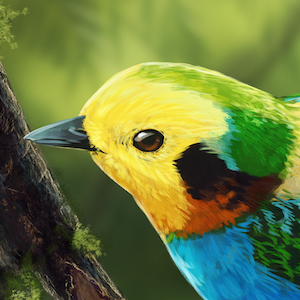The Boreal Forest of Canada and the northern US has been called "North America’s Bird Nursery", and rightfully so. According to the Boreal Songbird Initiative, about 50% of the continent’s bird species either breed in the boreal forest or refuel there on their migration to and from the tundra. Approximately 1-3 billion birds breed in the forest every year. The boreal forest is brimming with birds and though the forest’s human population is relatively sparse, it doesn’t mean that we aren’t leaving a mark. Some of Canada’s biggest petroleum deposits lie beneath the boreal forest and wherever there is petroleum, there tends to be a lot of human activity.
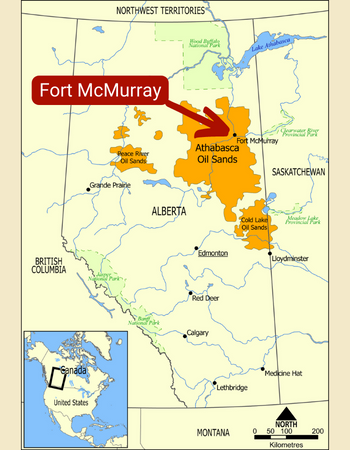
Map of the Athabasca Oil Sands by Norman Einstein/public domain.
In a new paper that was featured as the "Editor's Choice" in the journal Ornithological Applications, IBP research ecologist Jim Saracco, along with colleagues from IBP, Owl Moon Environmental Inc., and the University of Alberta, used 10 years of demographic data from the MAPS bird banding program to estimate trends over time and look at how the populations of 31 species are responding to habitat disturbance in the region. The study used data from 38 MAPS stations in the vicinity of Ft. McMurray, Alberta which sits atop the Athabasca Oil Sands, the largest deposit of crude oil on the planet. Energy development in this region has resulted in increasing habitat disturbance (such as mine sites and pipelines) in recent decades, including over the study period (from 2011 to 2020.)
To measure disturbance's effects on birds, the researchers used a fine-scale, locally-derived 2018 dataset to measure overall area transformed from a state of natural ecosystem cover, known as "human fooprint," surrounding each MAPS station. They also looked at how the human footprint changed over time using footprint data from 2010 and comparing it to the 2018 data. Whether disturbance is increasing, staying the same, or decreasing (returned to a state similar to its pre-disturbance state) would likely affect the number and types of birds using a given habitat and how well that habitat supports their populations.
Footprint increased overall, and there was substantial variation among sites in the magnitude of these changes. Some sites changed little, while others showed large increases in footprint across the study period. However, the most- and least-disturbed stations were largely the same between the two time points. Disturbed portions of study area present at the start of the study included a diverse mosaic of habitats in various stages of vegetation regrowth following the initial disturbance. In contrast, new disturbances that occurred since the study’s start would have largely represented habitat loss or very early successional habitats. Considering not just the extent of footprint, but its change over time, and relating it to three different demographic variables, not just abundance, allowed the researchers to develop a more detailed picture of the complex effects of human activity on boreal breeding songbirds.
The researchers found that “overall human footprint,” the extent of footprint as measured in 2018, and the “change in footprint over time,” often had different effects on bird abundance and demographic variables. Saracco explains that these different effects primarily reflect how birds respond differently to new disturbance and habitat loss versus older disturbed areas which had reached an early successional forest stage.
Abundance and demographic rates of birds tended to decline across the study period, while human footprint was increasing across the sites as a whole. Furthermore, abundance, productivity, and survival all tended to have more negative trends at sites with larger increases in footprint over time. The researchers suggest that these declines reflect new habitat loss due to human development, though other factors could have a role.
As long as footprint at a given banding station was not increasing, the extent of disturbance had little effect on adult survival (the likelihood of the same adult individual being captured at the station from one year to the next.) This was consistent with results of other studies and likely reflects the fact the these (mostly) migratory species spend the majority of the year either migrating or on their wintering grounds where they face numerous other threats to survival. Other factors, such as habitat loss on the wintering grounds, may have greater effects on adult survival than changing habitat on the breeding grounds.
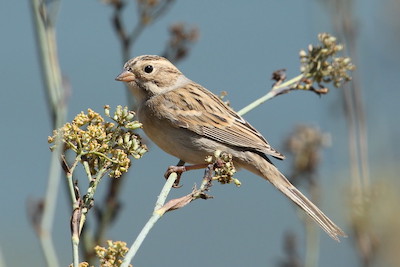
A Clay-colored Sparrow. Photo by Aaron Maizlish/Flickr.
Although total bird abundance declined as human footprint increased, there was no significant effect of overall footprint on abundance; rather, the proportion of different species changed. Species that are typically associated with later successional, undisturbed forest, such as Canada Warbler, were less common at sites with larger human footprint. But the abundance of some species was much greater in disturbed areas. These species, including Clay-colored and Savannah sparrows, species which prefer forest openings and early successional habitats.
“Residency,” or the probability that a newly banded adult would be recaptured at the same site in a given year (indicating it’s a resident, not just a migrant passing through) was negatively correlated with overall human footprint. This may be because these disturbed areas are less desirable for nesting, and males that settle in them move on if they can’t attract a mate. (For more discussion of habit selection see this related study.
Productivity (probability of a captured bird being a juvenile) declined over the course of the study period as human footprint increased, likely because birds avoided newly disturbed areas. But overall footprint extent, which pre-existing older disturbed habitats, had a different effect on productivity. The researchers found a generally positive relationship between productivity and overall footprint. This was even true for many species that are typically associated with older, undisturbed forest. Saracco suggests that this is likely due to fledglings and parents moving into early successional habitats such as disturbed areas where vegetation was recovering or restored and which tend to have a dense understory: “The post-fledging period is a particularly vulnerable time when a lot of mortality likely occurs. I think that cover of earlier successional habitats is especially important during that time.”

An Overbird collecting nest material. Photo by Tom Murray/Flickr.
But if early successional, post-disturbance habitat is so productive for so many species, why don’t they use that habitat all the time? Why don’t we see the same relationship between abundance and footprint that we see between productivity and footprint? “I think there are just different habitat requirements at different phases of the life cycle,” says Saracco. “For instance, during the nesting period, other characteristics, such as nest sites, particular food resources, etc. may be more important in driving habitat selection.” And there were species, e.g. Ovenbird and Least Flycatcher, for which adult abundance was higher in more disturbed sites but had lower productivity at those sites. This suggests that while early-successional habitats that develop in the wake of disturbance may provide important food and cover for post-fledging juveniles of many species, these habitats may represent “ecological traps” for other species, whereby adults are attracted to the habitat type but then don’t reproduce successfully there, leading to population decline.
The good news out of this study is that given time and restoration, areas disturbed by energy development can provide important boreal bird habitat for many species at certain points in their life cycle, although the process may take many years and not all species will be affected equally. “Resource development, which has increased in recent decades, represents a potentially serious threat to these bird populations,” says Saracco. “Our results suggest that habitat regeneration and restoration in the wake of disturbance can provide important breeding and post-breeding habitat for many of these bird species. However, other species that depend on more mature forests are more sensitive to disturbance, and their conservation will require minimizing any new future resource development footprint.”




